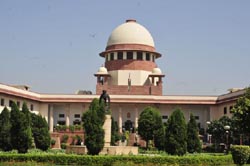Supreme Court upholds collegium system for appointment of Judges in Higher Judiciary
Sakshi Education
The Supreme Court on 16th October declared National Judicial Appointment Commission or NJAC Act as unconstitutional.


NJAC Act was meant to replace the two-decade old collegium system of appointing judges in higher judiciary. The Apex Court rejected the Centre’s plea that the petition challenging NJAC Act be referred to a larger bench.
The petitions challenging the new legislation were filed by Supreme Court Advocates on Record Association and others contending that the new law on the selection and appointment of judges was unconstitutional and aimed at hurting the independence of judiciary.
However, the Centre had defended the introduction of the new law saying that the two-decades-old collegium system in which judges appointed judges was not free from defects. It got the support of the Supreme Court Bar Association and 20 state governments which ratified the NJAC Act and the constitutional amendment.
NJAC: NJAC was a six-member body consisting of Chief Justice of India, two senior most Supreme Court judges, law minister and two nominated members to replace the two-decade old collegium system of appointment of judges in higher judiciary.
The Apex Court has also rejected the plea of Centre that the petition challenging NJAC Act be referred to a larger bench.
The Executive maintains that the National Judicial Appointments Commission Act was part of judicial reforms in the country and had the backing of the entire Parliament and prominent jurists. All eyes will now be on the November 3rd hearing and the suggestions to improve the collegium system.
Collegium System and NJAC
The collegium system of judicial appointments was put in place in 1993. NJAC was made a law through 99 amendment act, which was struck by a five-judge Bench, It is through this amendment act Government established a National Judicial Appointments Commission to select members of the higher judiciary.
There were doubts whether the composition of the NJAC, especially the inclusion in it of the Union Law Minister and two “eminent persons” appointed by the government, would survive judicial scrutiny. For, the law also gave any two members a veto over all decisions, raising the question whether the judicial members could be overruled by the executive representatives.
The Attorney General could not convince the court that the amendment, along with the NJAC Act, was aimed at restoring the system of checks and balances which, according to the government, was lost after the Supreme Court created the collegium scheme of appointments.
Independence of the judiciary- basic feature of the Constitution
The core question was whether the new institutional mechanism to appoint judges impinged on the independence of the judiciary, a basic feature of the Constitution. The court has ruled that it does.
Justice J.S. Khehar, writing the main judgment, has held that the clauses provided in the amendment are inadequate to preserve the primacy of the judiciary. The inclusion of the Law Minister in the body impinged on both the independence of the judiciary and the doctrine of separation of powers.
Nobody on either side of the debate disagrees that the judiciary should be insulated from political interference. Yet, should the judiciary retain its primacy, or should the executive have a say in order that flawed choices do not erode the institution’s credibility? Justice Khehar has said the conduct of the political executive showed it tended to reward favourites in many fields. Preserving the primacy of the judiciary was a safe way to shield the institution from “the regime of the spoils system”.
Even while restoring this system, the majority has invited suggestions to improve it so that it is more responsive to the expectations of civil society. While to some it may appear that striking down a Constitution amendment passed unanimously in both Houses of Parliament and ratified by 20 State Assemblies amounts to negating the people’s will, it cannot be forgotten that the judiciary remains the sole authority to decide whether a law violates the basic structure of the Constitution.
What the situation indicates is that India is still struggling to put together a transparent appointment system not vitiated by executive patronage or judicial nepotism.
The petitions challenging the new legislation were filed by Supreme Court Advocates on Record Association and others contending that the new law on the selection and appointment of judges was unconstitutional and aimed at hurting the independence of judiciary.
However, the Centre had defended the introduction of the new law saying that the two-decades-old collegium system in which judges appointed judges was not free from defects. It got the support of the Supreme Court Bar Association and 20 state governments which ratified the NJAC Act and the constitutional amendment.
NJAC: NJAC was a six-member body consisting of Chief Justice of India, two senior most Supreme Court judges, law minister and two nominated members to replace the two-decade old collegium system of appointment of judges in higher judiciary.
The Apex Court has also rejected the plea of Centre that the petition challenging NJAC Act be referred to a larger bench.
The Executive maintains that the National Judicial Appointments Commission Act was part of judicial reforms in the country and had the backing of the entire Parliament and prominent jurists. All eyes will now be on the November 3rd hearing and the suggestions to improve the collegium system.
Collegium System and NJAC
The collegium system of judicial appointments was put in place in 1993. NJAC was made a law through 99 amendment act, which was struck by a five-judge Bench, It is through this amendment act Government established a National Judicial Appointments Commission to select members of the higher judiciary.
There were doubts whether the composition of the NJAC, especially the inclusion in it of the Union Law Minister and two “eminent persons” appointed by the government, would survive judicial scrutiny. For, the law also gave any two members a veto over all decisions, raising the question whether the judicial members could be overruled by the executive representatives.
The Attorney General could not convince the court that the amendment, along with the NJAC Act, was aimed at restoring the system of checks and balances which, according to the government, was lost after the Supreme Court created the collegium scheme of appointments.
Independence of the judiciary- basic feature of the Constitution
The core question was whether the new institutional mechanism to appoint judges impinged on the independence of the judiciary, a basic feature of the Constitution. The court has ruled that it does.
Justice J.S. Khehar, writing the main judgment, has held that the clauses provided in the amendment are inadequate to preserve the primacy of the judiciary. The inclusion of the Law Minister in the body impinged on both the independence of the judiciary and the doctrine of separation of powers.
Nobody on either side of the debate disagrees that the judiciary should be insulated from political interference. Yet, should the judiciary retain its primacy, or should the executive have a say in order that flawed choices do not erode the institution’s credibility? Justice Khehar has said the conduct of the political executive showed it tended to reward favourites in many fields. Preserving the primacy of the judiciary was a safe way to shield the institution from “the regime of the spoils system”.
Even while restoring this system, the majority has invited suggestions to improve it so that it is more responsive to the expectations of civil society. While to some it may appear that striking down a Constitution amendment passed unanimously in both Houses of Parliament and ratified by 20 State Assemblies amounts to negating the people’s will, it cannot be forgotten that the judiciary remains the sole authority to decide whether a law violates the basic structure of the Constitution.
What the situation indicates is that India is still struggling to put together a transparent appointment system not vitiated by executive patronage or judicial nepotism.
Published date : 17 Oct 2015 04:39PM













